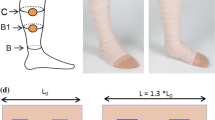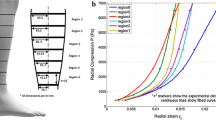Abstract
Compression therapy with stockings or bandages is the most common treatment for venous or lymphatic disorders. The objective of this study was to investigate the influence of bandage mechanical properties, application technique and subject morphology on the interface pressure, which is the key of this treatment. Bandage stretch and interface pressure measurements (between the bandage and the leg) were performed on 30 healthy subjects (15 men and 15 women) at two different heights on the lower leg and in two positions (supine and standing). Two bandages were applied with two application techniques by a single operator. The statistical analysis of the results revealed: no significant difference in pressure between men and women, except for the pressure variation between supine and standing positions; a very strong correlation between pressure and bandage mechanical properties (p < 0.00001) and between pressure and bandage overlapping (p < 0.00001); a significant pressure increase from supine to standing positions (p < 0.0001). Also, it showed that pressure tended to decrease when leg circumference increased. Overall, pressure applied by elastic compression bandages varies with subject morphology, bandage mechanical properties and application technique. A better knowledge of the impact of these parameters on the applied pressure may lead to a more effective treatment.







Similar content being viewed by others
References
Agu, O., G. Hamilton, and D. Baker. Graduated compression stockings in the prevention of venous thromboembolism. Br. J. Surg. 86(8):992–1004, 1999.
Al Khaburi, J., A. A. Dehghani-Sanij, E. A. Nelson, and J. Hutchinson. Effect of bandage thickness on interface pressure applied by compression bandages. Med. Eng. Phys. 34(3):378–385, 2012.
Benigni, J. P., J. F. Uhl, A. Cornu-Thénard, and E. Blin. Compression bandages: influence of techniques of use on their clinical efficiency and tolerance. Int. Angiol. 27(1):68–73, 2008.
Bhattacharya, S., T. Shaikh, and R. Purushottam Solao. Development of prototype bandage lapper for constant tension bandaging required for effective medical-clinical treatments. J. Tissue Viability 21(2):54–63, 2012.
Brizzio, E., F. Amsler, B. Lun, and W. Blättler. Comparison of low-strength compression stockings with bandages for the treatment of recalcitrant venous ulcers. J. Vasc. Surg. 51(2):410–416, 2010.
Coull, A., D. Tolson, and J. McIntosh. Class-3c compression bandaging for venous ulcers: comparison of spiral and figure-of-eight techniques. J. Adv. Nurs. 54(3):274–283, 2006.
Damstra, R. J., and H. Partsch. Prospective, randomized, controlled trial comparing the effectiveness of adjustable compression Velcro wraps versus inelastic multicomponent compression bandages in the initial treatment of leg lymphedema. J. Vasc. Surg. Venous Lymphat. Disord. 1(1):13–19, 2013.
Danielsen, L., S. Munk Madsen, L. Henriksen, J. Sindrup, and L. J. Petersen. Subbandage pressure measurements comparing a long-stretch with a short-stretch compression bandage. Acta Derm. Venereol. 78:201–204, 1998.
Hafner, J., W. Lüthi, H. Hänssle, G. Kammerlander, and G. Burg. Instruction of compression therapy by means of interface pressure measurement. Dermatol. Surg. 26(5):481–488, 2000.
Hanna, R., S. Bohbot, and N. Connolly. A comparison of interface pressures of three compression bandage systems. Br. J. Nurs. Mark Allen Publ. 17(20):S16–S24, 2008.
Hirai, M., K. Niimi, H. Iwata, et al. A comparison of interface pressure and stiffness between elastic stockings and bandages. Phlebology 24(3):120–124, 2009.
Huston, R. L. Principles of Biomechanics. Boca Raton: CRC Press, 2009.
Lattimer, C. R., E. Kalodiki, M. Kafeza, M. Azzam, and G. Geroulakos. Quantifying the degree graduated elastic compression stockings enhance venous emptying. Eur. J. Vasc. Endovasc. Surg. 47(1):75–80, 2014.
Milic, D. J., S. S. Zivic, D. C. Bogdanovic, et al. The influence of different sub-bandage pressure values on venous leg ulcers healing when treated with compression therapy. J. Vasc. Surg. 51(3):655–661, 2010.
Mosti, G., and V. Mattaliano. Simultaneous changes of leg circumference and interface pressure under different compression bandages. Eur. J. Vasc. Endovasc. Surg. 33(4):476–482, 2007.
Mosti, G., and H. Partsch. Inelastic bandages maintain their hemodynamic effectiveness over time despite significant pressure loss. J. Vasc. Surg. 52(4):925–931, 2010.
Mosti, G., and H. Partsch. Bandages or double stockings for the initial therapy of venous oedema? A randomized, controlled pilot study. Eur. J. Vasc. Endovasc. Surg. 46(1):142–148, 2013.
Mosti, G., and H. Partsch. Improvement of venous pumping function by double progressive compression stockings: higher pressure over the calf is more important than a graduated pressure profile. Eur. J. Vasc. Endovasc. Surg. 47(5):545–549, 2014.
O’Meara, S., N. Cullum, E. A. Nelson, and J. C. Dumville. Compression for venous leg ulcers. In: Cochrane Database of Systematic Reviews, edited by The Cochrane Collaboration, and S. O’Meara. Chichester: Wiley, 2012.
Partsch, H. The use of pressure change on standing as a surrogate measure of the stiffness of a compression bandage. Eur. J. Vasc. Endovasc. Surg. 30(4):415–421, 2005.
Partsch, H. The static stiffness index: a simple method to assess the elastic property of compression material in vivo. Dermatol. Surg. 31(6):625–630, 2005.
Partsch, H., and G. Mosti. Comparison of three portable instruments to measure compression pressure. Int. Angiol. 29(5):426–430, 2010.
Partsch, B., and H. Partsch. Calf compression pressure required to achieve venous closure from supine to standing positions. J. Vasc. Surg. 42(4):734–738, 2005.
Partsch, H., M. Clark, S. Bassez, et al. Measurement of lower leg compression in vivo: recommendations for the performance of measurements of interface pressure and stiffness: consensus statement. Dermatol. Surg. 32(2):224–232, 2006; (discussion 233).
Raj, T. B., M. Goddard, and G. S. Makin. How long do compression bandages maintain their pressure during ambulatory treatment of varicose veins? Br. J. Surg. 67(2):122–124, 1980.
Rimaud, D., R. Convert, and P. Calmels. In vivo measurement of compression bandage interface pressures: the first study. Ann. Phys. Rehabil. Med. 57(6–7):394–408, 2014.
Rohan, P.-Y., P. Badel, B. Lun, D. Rastel, and S. Avril. Prediction of the biomechanical effects of compression therapy on deep veins using finite element modelling. Ann. Biomed. Eng. 43(2):314–324, 2015.
Thomas, S. The use of the Laplace equation in the calculation of sub-bandage pressure. Eur. Wound Manage. Assoc. 3:21–23, 2003.
Thomas, S. Practical limitations of two devices used for the measurement of sub-bandage pressure: implications for clinical practice. J. Wound Care. 23(6):300–313, 2014.
Thomas, S., and P. Fram. Laboratory-based evaluation of a compression-bandaging system. Nurs. Times. 99(40):24–28, 2003.
The International Lymphoedema Framework. Best Practice for the Management of Lymphoedema, 2nd edn.
Conflict of interest
Thuasne is a compression bandage manufacturer.
Author information
Authors and Affiliations
Corresponding author
Additional information
Associate Editor Amit Gefen oversaw the review of this article.
Rights and permissions
About this article
Cite this article
Chassagne, F., Martin, F., Badel, P. et al. Experimental Investigation of Pressure Applied on the Lower Leg by Elastic Compression Bandage. Ann Biomed Eng 43, 2967–2977 (2015). https://doi.org/10.1007/s10439-015-1352-1
Received:
Accepted:
Published:
Issue Date:
DOI: https://doi.org/10.1007/s10439-015-1352-1




